Waterfall Chasing: Canyon of Five Falls
Field Notes II.VI: Photographing the Wild and Scenic Chattooga River
Loose earth tumbles down the cliff face. Beneath my boots the damp leaves, soil, and rock making up this thin ledge shift and give. I press my chest to the mountainside, arms stretched, fingers searching for any solid hold. The weight of my pack gently pulls me backwards towards the void. I am tense and motionless above a 20 foot drop.
As I scrambled down the steep slope from the ridge crest this ledge appeared to be an easier route. Steeper, yes, but free of the entanglement of rhododendron branches all around. Now I find myself on an unstable, exposed precipice. I cannot go back, and am re-thinking all of the decisions that led me to this place. This was intended as a quick day trip, but I now find myself deep in the wild, off trail, and I hadn’t told anyone where I was going.
There is a rock foothold to my right. Just outside of my reach is a solid root I could grab. I need to make a committed step to reach them. What if the rock gives way? The ground underfoot continues to disintegrate. I must make a move. One more tense breath and… I step.
Welcome to Field Notes!
Today’s forecast is promising. Overcast. These are days made for chasing waterfalls. Direct sunlight on whitewater makes photography incredibly hard. Overcast is better. There were heavy rains in late January, but a long stretch of clear blue skies has given time for any flooding to recede.
The Chattooga River flows from headwaters in the Appalachian Mountains to form the border of Georgia and South Carolina. Its official designation as a ‘Wild and Scenic’ river means that it is protected in its natural state. It is renowned for its beauty and is a popular destination for hikers, campers, and kayakers.
Along the Chattooga’s length is a stretch known as the Canyon of Five Falls, a famous challenge for whitewater kayakers. However, there are no trails to this canyon. For travelers on foot, it is largely a mystery. In researching the trip, one account describes an easy trackless walk along the edge of the river, requiring a brief wade in the waters to continue. The past two days have been unseasonably warm, so I pack my water shoes.
I leave in darkness under a hazy moon. There is cloud cover, but not thick. The headlights of my truck cut the dark, illuminating yellow lines and reflective white dashes that merge at a vanishing point in the distance. I did not plan to photograph the sunrise, but as tires hum on the highway I notice the clouds glowing to the east. The sky becomes a field of embers scattered amongst ash, and this fire is rekindling. Behind bare trees whipping past, over shadow laden fields, the crimson hue erupts and spreads.
In the growing light I can only glance in amazement and look forward to an eastward curve of the road. Can I learn gratitude for witnessing such moments without the ever present desire to photograph it?
Turning off of the main roads, a narrow single track dirt drive leads deep into the woods, passing old houses where barking dogs give chase. A cluster of mobile homes stands long abandoned and decaying. It is a stereotypical stage for banjos and a meth lab, but only occupied by a lonely tawny horse watching with envy as I drive past.
The dirt road terminates at the border to the protected corridor of the Chattooga. From here, an easy, well worn trail meanders down towards the river. Now daylight, I see that the clouds, though thin, have remained. But the temperature drops. I watch the thermometer dip below freezing and regret not bringing gloves.
Winter lingers. The forest is adorned with the bright copper leaves of beech trees. These trees hold their foliage until the spring and stand blazing on the otherwise bare hillsides. Small hemlocks hug the sides of the path.
The trail quickly reaches the sandy banks of the Chattooga River. Here it is broad and calm. The water is remarkably clear, revealing submerged stones, tinted with deep greens and blue. Ever present rhododendron grows scattered all the way to the water’s edge. The low growl of the water’s motion is the only sound.
I follow the trail downstream. It is an easy walk until it reaches the confluence of Camp Creek. Netted dogbane clusters around the stream in dense patches. There is no bridge and a cautious scramble leads me to the far side, where I must leave the trail. Ahead, the river sharply bends around a jutting ridge of mountain. Unseen on the far side lies the Canyon of Five Falls. I climb, duck, and maneuver amongst the boulders at the edge of the icy water to my left. To the right is a steep cliff, covered in impenetrable thickets of twisted branches.
This slow progression takes me only so far. Ahead is a massive rock face plunging into the water below. This should be the point to begin wading, but now I am looking at water that could easily be chest deep, if not more, with temperatures scarcely above freezing.
I cannot proceed that way today. I look back upstream. Is this the end of my journey today? What other option is there? A slight gap in the rhododendrons nearby would allow me to go up. Potentially, I could make my way over the top of the ridge and descend into the canyon beyond. The steepness is daunting. How much do I risk to see the canyon? Slowly, clinging to branches and knotted trunks, I start to climb.
The climb soon becomes a violent struggle. I scramble up the near vertical hillside, making progress and then sliding back. I am locked in a sweaty grappling match with the mountain. Rhododendron branches give me purchase and security, but ceaselessly snag my pack and pull me backward. The distance to the riverside boulders below grows and I do not look back.
Eventually, the underbrush thins and I emerge from the melee at the crest of the sharp ridge crowned in hemlock trees. An open forest covers the slope of the far side, easing into the canyon below. Waxy galax sprawls on the forest floor amid the leaf litter. Recovering from my fight for this high ground, I give it up in a descent towards the now roaring rapids.
Wedged between tall mountainsides, here the river crashes through massive boulders and shelves of cold gray rock. The din of the rapids is nearly overwhelming, but my brain soon filters it out of my awareness . The first rapid, Class IV, is known as Entrance Cascade. Here the water powers over a line of boulders strewn from bank to bank.
Shortly thereafter the entire river flow is channeled through a narrow passage to form a Class V rapid named The Corkscrew.
This is where I remain. I climb across the boulders, assessing and photographing. Frigid water spills over my boots as I lean out for compositions. Time flows by as quickly as the Chattooga. Just as I begin considering the falls further downstream I notice the hazy sun cresting the high canyon walls. Noon approaches, so I opt to save exploration of the next three rapids for a warmer day when wading will allow for faster progress. Before I return, I prepare a cup of coffee and enjoy the view.
The inclined hike back to the ridge crest exercises my lungs. At the apex I study the GPS for alternate routes back, rather than return on the same treacherous route I took to get here. I could follow the ridge line up, but every side of the mountain in the direction I am headed in appears just as steep. I look down.
The ground is soft dark earth, covered in a thick layer of fallen leaves. The numerous gnarled trunks and roots would provide plentiful handholds for the precipitous descent. I continue looking down. Despite my gut’s objection, my mind settles on this route as my best option.
I plunge down the mountainside. At times I am in a controlled slide, slowed by snags of tripod on twisted limbs. I claw at the soil and roots for handholds. The terrain and dispersion of flora channel me along a familiar route. It is very close to the same that I took on the climb up. Perhaps, intuitively, I have found the only traversable way.
I must pause. To my right is an especially tangled network of shrubbery. To the left is an angled rock cliff, clear of bushes, and with what looks like a walkable ledge. I climb in that direction, but quickly discover that the ledge is highly unstable. The ground shifts beneath me. I am beyond the point of return and embrace the mountainside with my chest. I inch along the crumbling rock and earth, sweaty and tense. The ground below me looks soft, but very far away. I smile at the fates watching me from the shadows. My only move is a large step to a rock to my right while reaching for a root beyond. I step. It is solid, and the root rough but firm. I continue my scamper down to the calmer waters below.
The Chattooga sprawls flat and tranquil before me. From sunrise until now, it has been a day of unexpected surprises and adventure. Uncertainty. Peril. Where is the line between too far and not enough? I am only beginning to define these edges. Now I sit and rest and watch the steady flow of water in peaceful gratitude.
This was a fun one! I’m very happy with these photos, but looking at them I ask myself ‘why didn’t I do this or that?’ Oh well, just one more reason to go back and explore the rest of these rapids!
I would love to hear your thoughts about the story, the photos, and your similar adventures. Lets continue the conversation in the comments!
Field Notes is a reader supported effort. If you enjoy these episodes then others will, too! Help spread the word by forwarding the email, sharing this post, or just telling your friends.
If you enjoyed this issue you might also like to check out this past episode of waterfall chasing-
Waterfall Chasing- Hemlock Falls
Welcome to Field Notes! Here’s what we have today- A look at Moccasin Creek in the North Georgia Mountains Photos I took on a day trip there on October 13, 2023 A premier of a short film I made of this trip In past issues of Field Notes I have made the included photos clickable links to my portfolio gallery where you can view them amongst my other photogra…


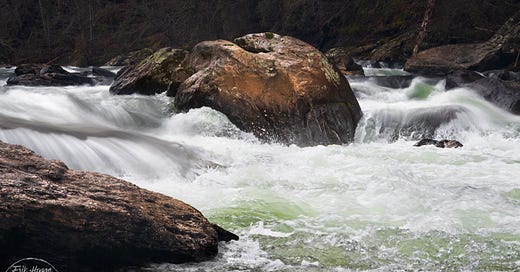



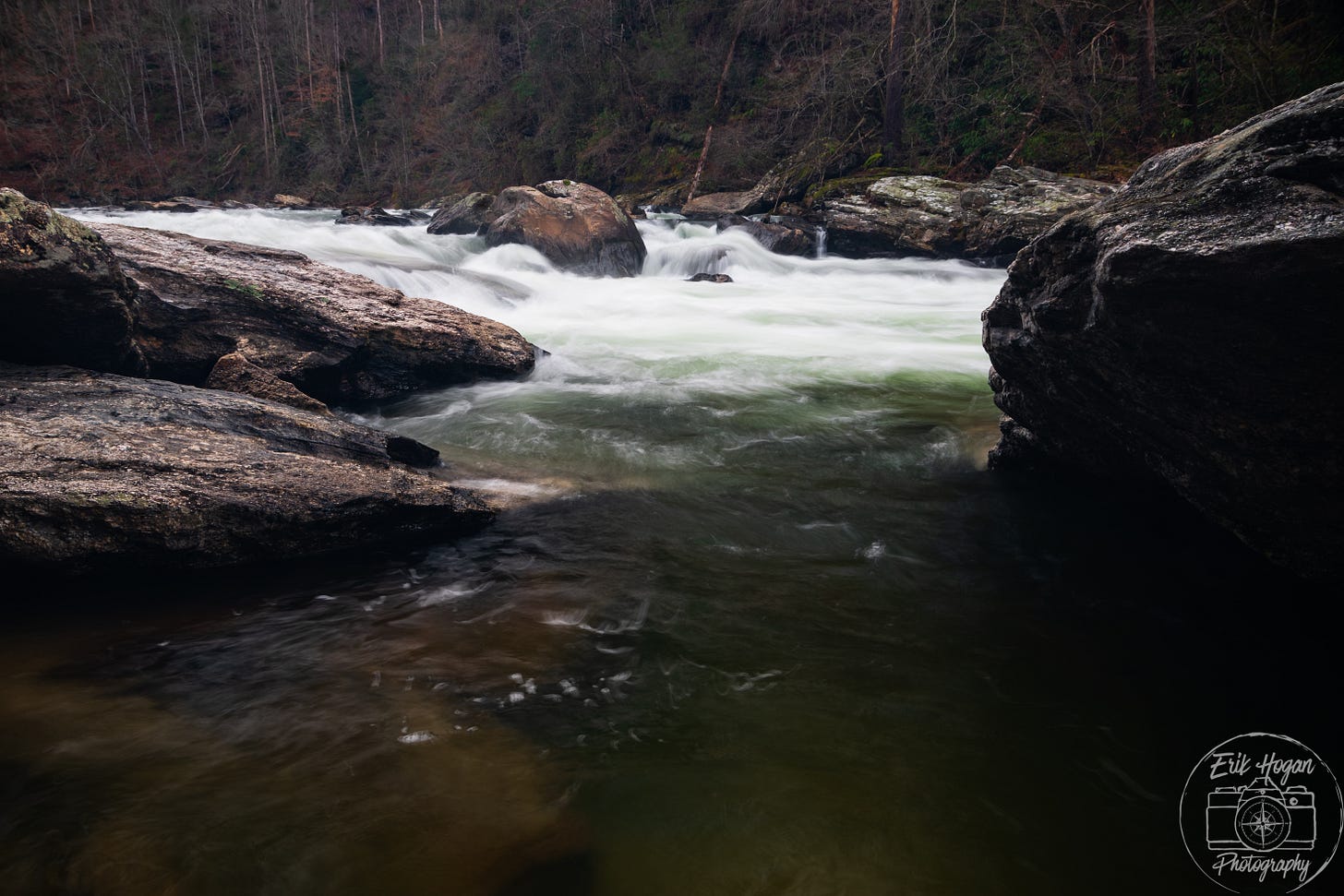

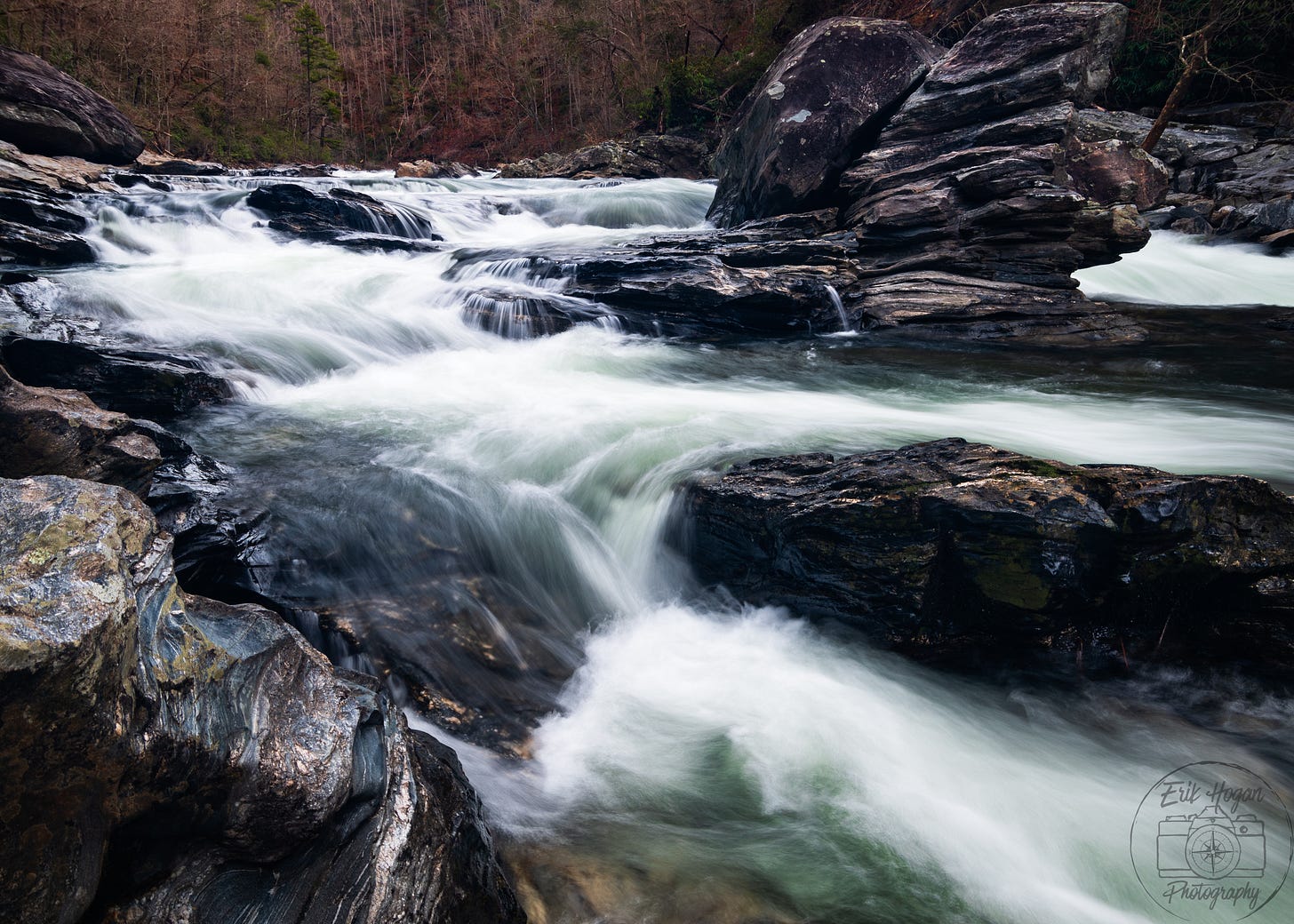
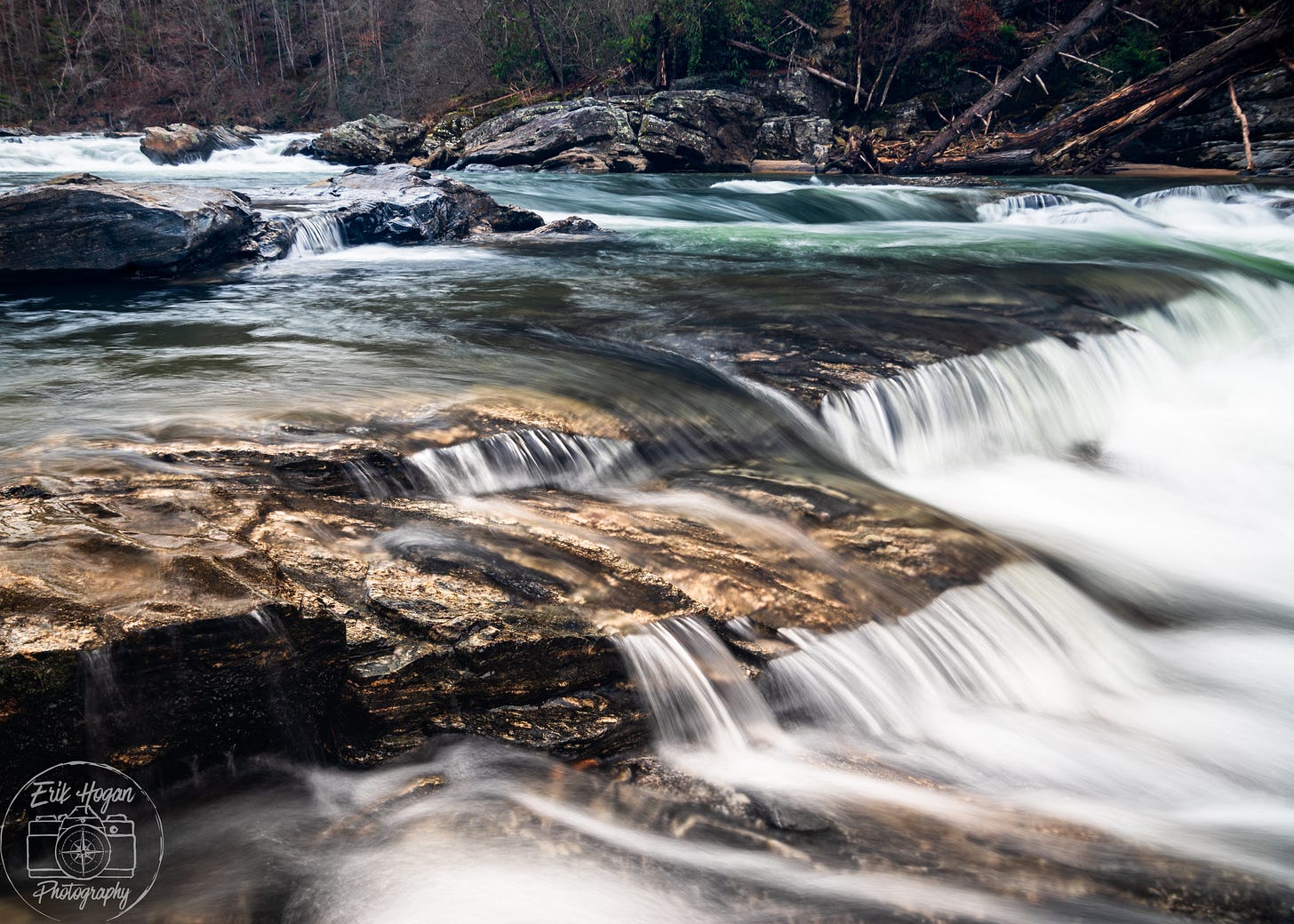

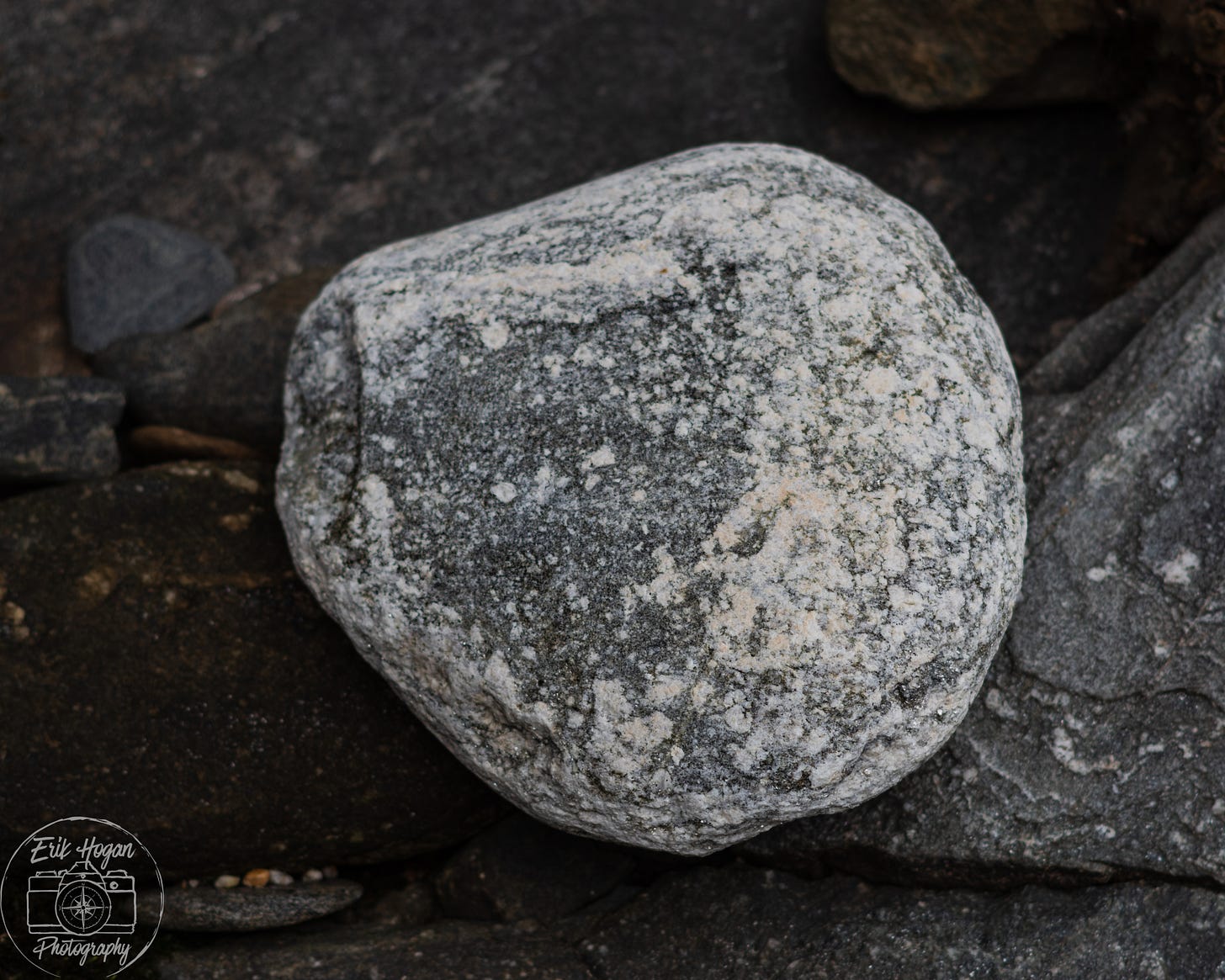

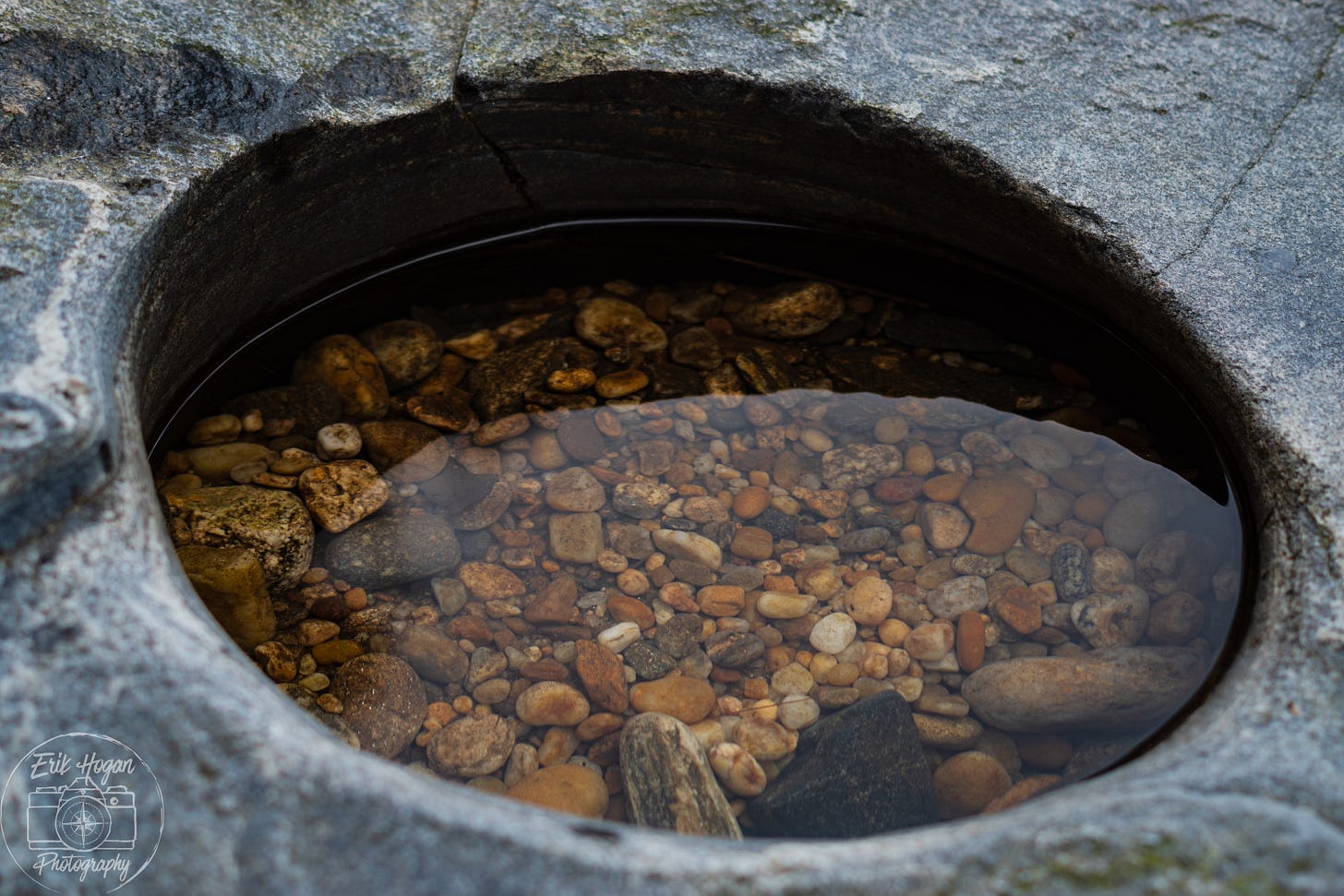


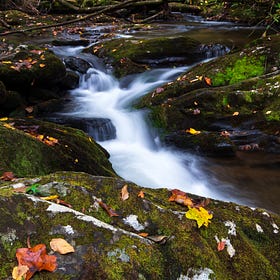
Haven’t been to that specific canyon, but have caught more than my fair share of brown trout in the Chatooga, and have hiked lots of the foothills trail that runs by it. Keep up the good work, man. Let’s hit the trails together soon!
Lovely images Erik and a really good read. It's always interesting to hear about other peoples photographic outings particularly as this one sounded more adventurous than mine ever are.
I liked the comment about learning to feel gratitude for witnessing moments without feeling the need to photograph them. I am trying to do the same myself but its not easy - the desire to reach for my camera is always too strong! 🙂